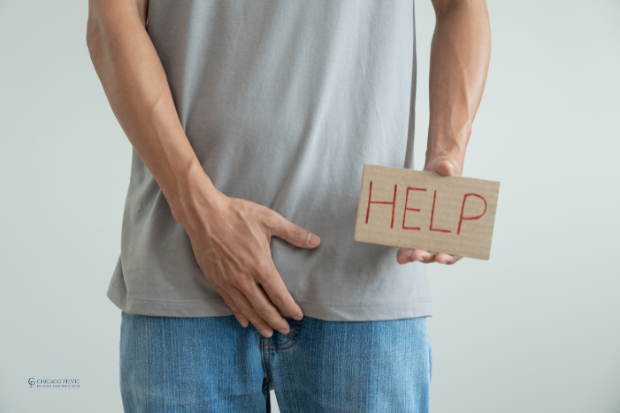Groin Pain in Men: Causes, Symptoms, and Treatment with a Board Certified Pelvic PT
Understanding Causes, Recognizing Symptoms, and Treating
Groin pain in men is a prevalent issue that can significantly affect daily activities and overall quality of life. It refers to discomfort or pain in the area where the abdomen ends, and the legs begin. Addressing groin pain is crucial as it can stem from various causes, some of which may require immediate medical attention. Understanding these causes and the best treatment options, including Pelvic Physical Therapy (PT), can help manage and alleviate this condition effectively.
Common Symptoms of Groin Pain
Groin pain manifests differently for each individual but commonly includes several symptoms:
Sharp or Dull Pain: Pain may range from mild discomfort to severe throbbing sensations.
Swelling or Bruising: Visible signs of inflammation or discoloration in the groin area.
Stiffness and Reduced Mobility: Difficulty moving the hip or leg freely.
Burning Sensation: Uncomfortable tingling or burning pain in the groin area.
Pain During Physical Activities: Exacerbated pain during exercise, walking, or sudden movements.
These symptoms can vary based on the underlying cause of the groin pain, which can include several factors.
Common Causes of Groin Pain
Groin pain can stem from various conditions, including muscle, tendon, or ligament strains, hernias, kidney stones, infections, nerve entrapment, and even referred pain from the lower back or hip.
1. Groin Strain
Groin strains occur when the muscles in the male pelvis area are overstretched or torn, often due to sudden movements or physical activities.
2. Inguinal Hernia
An inguinal hernia occurs when abdominal contents protrude through a weak spot in the abdominal wall, often causing a visible bulge and discomfort in the groin area.
3. Prostatitis
Inflammation of the prostate gland can cause pain in the groin, pelvis, or lower back, accompanied by urinary symptoms.
4. Epididymitis
Inflammation of the epididymis (tube at the back of the testicle that stores and carries sperm) causes pain and swelling in the testicular area.
5. Orchitis
Inflammation of the testicles, often due to viral or bacterial infections, leads to pain and swelling in the testicular region.
6. Testicular Torsion
A medical emergency where the spermatic cord twists, cutting off blood flow to the testicle, causing sudden and severe pain in the groin.
7. Testicular Cancer
While rare, testicular cancer can present as painless or painful lumps or swelling in the testicular area, accompanied by groin discomfort.
8. Hip Problems
Conditions such as osteoarthritis or labral tears in the hip joint can radiate pain to the groin area.
9. Kidney Stones
Hard deposits of minerals and salts that form inside the kidneys can cause severe pain as they pass through the urinary tract, often radiating to the groin.
10. Kidney Infection
Infections of the kidneys (pyelonephritis) can cause flank pain that may radiate to the groin area.
When to Seek Medical Help
If you experience persistent or severe groin pain, especially accompanied by fever, swelling, or difficulty urinating, seek medical attention promptly. Delayed treatment can exacerbate underlying conditions and lead to complications.
Diagnosing Groin Pain
When experiencing groin pain, seeking medical help for an accurate diagnosis and appropriate treatment is essential. Healthcare professionals typically begin by conducting initial medical assessments, patient histories, and physical examinations.
Initial Medical Assessments
During the patient history assessment, the doctor will ask about the nature of the pain, how long it has been present, any factors that trigger or worsen the pain, and if there are any accompanying symptoms.
Physical Examination
The doctor will visually inspect the affected area, looking for signs of swelling, redness, or visible abnormalities. They may gently palpate the groin region to check for tenderness or lumps.
Diagnostic Tests
Doctors may recommend additional diagnostic tests to further investigate the underlying causes of groin pain. These tests can include:
Imaging (X-ray, MRI, ultrasound): Provide a detailed view of the structures within the groin area.
Blood Tests: Identify signs of infection or inflammation.
Urine Tests: Check for possible urinary tract infections or kidney stones.
Treatment Options for Groin Pain
Treatment for groin pain varies based on the cause and severity:
Non-Surgical Treatments
Rest and Activity Modification: Avoid activities that exacerbate pain and allow adequate rest for recovery.
Ice and Heat Therapy: Alternating cold packs and warm compresses to reduce inflammation and alleviate discomfort.
Medications: Pain relievers, anti-inflammatories, or antibiotics (if infection is present) as prescribed by a healthcare provider.
Pelvic Floor Physical Therapy: Specific exercises to strengthen muscles, improve flexibility, and aid in rehabilitation, including Pelvic PT techniques.
Surgical Treatments
Hernia Repair: Surgical correction to address inguinal hernias and prevent further complications.
Surgery for Hip Issues or Testicular Conditions: Procedures to repair damaged tissues or address structural abnormalities.
Top 10 Tips to Prevent Groin Pain
Warm-up and Stretch: Before physical activity, exercise and stretch to prepare muscles and reduce strain.
Maintain Good Posture: Proper posture during activities and daily tasks can prevent undue stress on the groin and hip joints.
Stay Hydrated: Adequate hydration can help prevent kidney stones.
Use Protective Gear: Wear appropriate protective gear when participating in sports or high-risk activities.
Strengthen Core Muscles: A strong core can support the groin area and prevent injuries.
Avoid Overexertion: Gradually increase the intensity of physical activities to avoid sudden strain.
Practice Safe Lifting Techniques: Use proper techniques to lift heavy objects to avoid groin strain.
Manage Weight: Maintain a healthy weight to reduce stress on the groin muscles.
Regular Check-ups: Routine medical check-ups can help detect and address potential issues early.
Consult a Pelvic PT: Regular consultations with a Pelvic Physical Therapist can help maintain groin health and prevent injuries.
Conclusion
Groin pain in men can stem from various causes, ranging from muscle strains to severe medical conditions. Early recognition of symptoms, prompt medical evaluation, and appropriate treatment are essential to alleviate pain, prevent complications, and facilitate recovery. By understanding the underlying causes and implementing preventive measures, individuals can actively manage groin health and maintain optimal physical well-being.
Call to Action
If you are experiencing groin pain, don't wait for it to worsen. Consult with a board-certified Pelvic Physical Therapist today to start your journey toward recovery and improved quality of life. Visit our website at Chicago Pelvic Clinic to book an appointment or learn more about our specialized services.
FAQs
When should I worry about groin pain?
Persistent or severe groin pain, especially accompanied by swelling, fever, or difficulty urinating, warrants immediate medical attention.
How to get rid of groin pain in males?
Treatment options vary based on the cause but may include rest, medication, pelvic physical therapy, or surgical intervention, as recommended by a healthcare provider.
Is walking good for groin pain?
Moderate walking can be beneficial for gentle movement and promoting blood flow, but avoid activities that exacerbate pain until evaluated by a healthcare professional.
Written by:
Dr. Jana Richardson, PT, DPT, WCS, PRPC, CIDN
Dual Board-Certified Pelvic Floor Therapist, Owner of Chicago Pelvic Health, and 2026 Elected Director of the Male Health Special Interest Group for the APTA Pelvic Health Section
Dr. Jana Richardson is a highly accomplished pelvic floor therapist with dual board certifications and extensive experience in treating complex pelvic floor dysfunctions. As the owner of Chicago Pelvic Health, Dr. Richardson is dedicated to providing personalized and effective care for her patients. She holds a Doctorate in Physical Therapy and advanced board certifications in Women’s Health (WCS) and Pelvic Rehabilitation (PRPC), positioning her as a leading expert in her field.
Dr. Richardson is also certified in Integrative Dry Needling (CIDN), allowing her to deliver comprehensive and targeted treatment strategies. In addition to her clinical work, she has been elected as the 2026 Director of the Male Health Special Interest Group for the APTA Pelvic Health Section, where she advocates for advancing male pelvic health care nationwide. Her commitment to patient-centered care and her passion for helping individuals achieve optimal pelvic health make her an invaluable resource to the community and her profession.
Connect with our team on our Social Media accounts to learn more!

